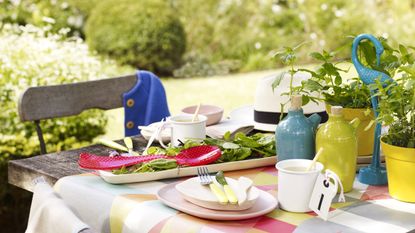Poppy Okotcha shares her low maintenance technique that will boost your garden and kitchen this season
It’s time to indulge in the benefits of a forest garden – the Poppy Okotcha way


With so much to love about forest gardens, it is unsurprising they are one of the biggest modern garden ideas of the season. The concept not only fills our gardens with aesthetic plants and lush greenery, but it supplies us with an array of aromatic treats that will bless our kitchens with homegrown culinary delights. And the best part? Forest gardens are gloriously low maintenance, as the vast number of plants used are almost entirely self-sufficient.
We can think of no better person to come to for forest garden advice than celebrity gardener and Livingetc columnist Poppy Okotcha, who shares her expert tips, so we can get busy embracing this ever-popular trend. We have no doubt that our gardens and our kitchens will thank us for getting involved.

During the first episode of Channel 4’s The Great Garden Revolution, presenter Poppy categorized the forest garden into layers, beginning with the largest tree and ending with the soil surface.
‘You can have tall trees (up to ten meters), vines, shrubs, herbaceous plants, and then you’ll have a ground cover that is protecting the soil. All of these plants interact with each other in a beneficial way, so you end up planting a mini-ecosystem,’ Poppy begins.
‘Forest gardens are full of plants with a purpose. [They include] edible and medicinal species – from fruit trees and vines to herbs and leafy plants. As the leaves drop, they are left to form a compost layer to feed the earth and lock in carbon,’ she adds.
See: Outdoor kitchen ideas: Cool ideas for a chic and functional alfresco cooking and dining space

Forest garden layer 1: The canopy
Firstly, Poppy demonstrates how to plant the first layer with a strawberry tree, but any large fruit tree is suitable.
‘We’re going to start with the canopy. [The strawberry tree] might seem small [at first], but this tree can grow up to five meters,' she explains.
Forest garden layer 2: The shrubs & vines
Poppy then moves down to the and vine layer, and notes that brambles 'like to lop over stuff.'
'As the strawberry tree starts to grow, it will cast a bit of shade, and the blackberry can tolerate that shade,’ Poppy shares.
Forest garden layer 3: The herbaceous layer
Next, Poppy tackles the middle herbaceous layer, whose ‘stalks and shoots make great candied sweets’. She also adds hostas, whose ‘new, unfurled leaves, can be cooked up as a snack.’ Alongside these sweet jewels, we can use perennial vegetables and herbs that are equally as important in the forest garden and beneficial to our summer dinner party dishes.

Forest garden layer 4: The ground cover
See: No dig expert tips: Livingetc's gardening columnist Poppy Okotcha on how to plant a modern vegetable and flower garden
Finally, the ground cover layer is made of edible plants that grow horizontally and discourage invasive species, including nettles and brambles, from taking over the forest.
‘[Here] we’ve got mint – this plant typically, you would not recommend planting outside of a container because it spreads. But in this setting, we are going to plant it because the whole point is that it will spread everywhere. It will create a map on the soil and act as the ground cover.'
She continues: ‘Joining the mint, I’m adding one of my favorite plants to put in to use in salads – lemon balm. And finally, a more surprising edible plant – violets. Violets are going to spread slowly but surely around on the soil. The flowers and the leaves are all edible.’
Armed with Poppy Okotcha’s expertise, we’re going to indulge in a garden full of organic edible pleasures throughout the sun-kissed summer months and beyond.
Be The First To Know
The Livingetc newsletter is your shortcut to the now and the next in home design. Subscribe today to receive a stunning free 200-page book of the best homes from around the world.
Megan is the News and Trends Editor at Homes & Gardens. She first joined Future Plc as a News Writer across their interiors titles, including Livingetc and Real Homes. As the News Editor, she often focuses on emerging microtrends, well-being stories, and celebrity-focused pieces.
Before joining Future, Megan worked as a News Explainer at The Telegraph, following her MA in International Journalism at the University of Leeds. During her BA in English Literature and Creative Writing, she gained writing experience in the US whilst studying in New York. Megan also focused on travel writing during her time living in Paris, where she produced content for a French travel site.
-
 How to Thaw a Frozen Pipe — Learn Everything You Need to Know in 5 Minutes With This Guide
How to Thaw a Frozen Pipe — Learn Everything You Need to Know in 5 Minutes With This GuideWinter storm caught you off guard? We asked an expert — just how do you thaw a frozen pipe?
By Hugh Metcalf Published
-
 The 12 Very Best Silk Bedding Pieces — As Our Style Editor Says: 'It's What Dreams Are Made Of!'
The 12 Very Best Silk Bedding Pieces — As Our Style Editor Says: 'It's What Dreams Are Made Of!'Slumber in lustrous luxury with the very best silk bedding sheets, duvets, pillowcases, and more — your sleep score will thank us later
By Julia Demer Published

